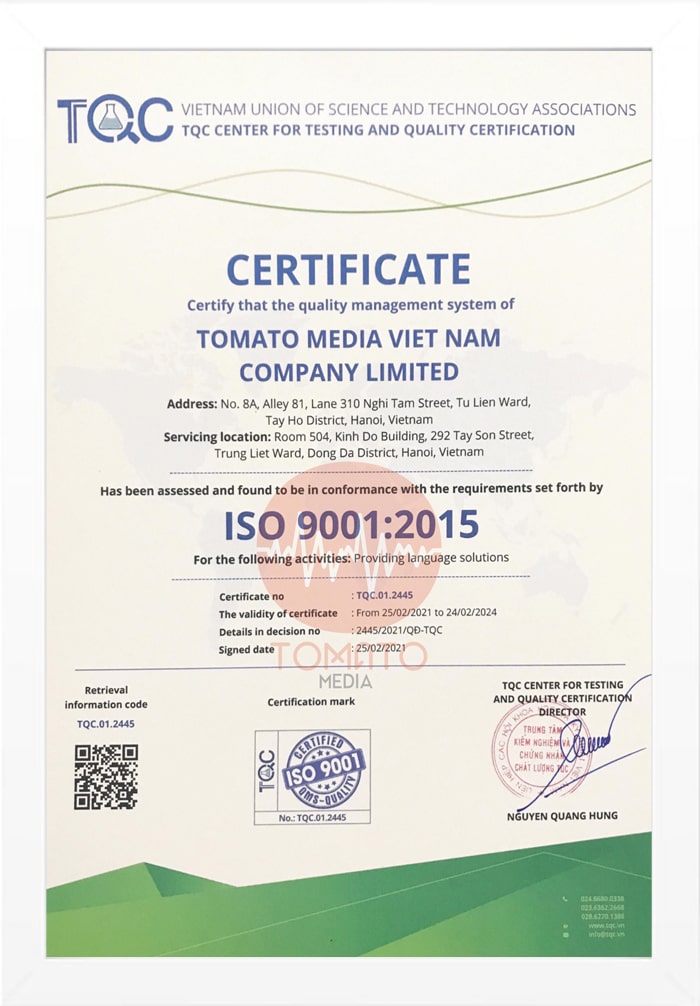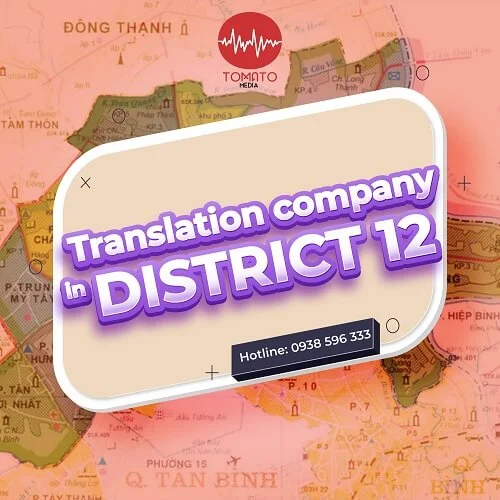Summary of reputable and quality translation and notarized translation units and companies in District 12 The following are the prestigious and high-quality companies and translation units in District 12 that we have compiled: No. Notarized translation in District 12 District 12 Translation Address 1 Translation services in District 12 – Tomato Media Translation Company 24/7 [...]
The most detailed China translation rules needed to follow
Chinese is one of the languages with very high difficulty but is extremely popular. A Chinese translation has a lot of rules for the translation of sentences, paragraphs, and meaning. In the article below, Tomato Media will help you gather some basic yet necessary Chinese translation rules for both learners and translators.
Tomato Media is also a high-quality Chinese translation and interpretation company; contact us immediately if you need this service!
NỘI DUNG (CONTENT)
Chinese translation rules: literal but not “word by word”
The forbidden point in the Chinese translation rules is the word-by-word translation. Chinese has ideographs as its characteristic. In addition, there is also a difference between the meaning, usage of traditional Chinese and simplified Chinese. The word creates diversity in the manner of writing, the rules of pronunciation and the meaning of the word.
The way of writing in Chinese is very diverse and rich. A translator’s task is to translate closely with the meaning of the original text but not mechanically translate each word. There should be a connection in a sentence, between sentences, and between sentences and paragraphs.
Sometimes, due to the characteristics of works of literature or books, a translation needs to be quite free without being limited to literal words. However, it is still necessary to follow the principle of retaining the main meaning that the original text wants to convey.
Chinese sentence translation rules
The next Chinese translation rule to pay attention to is sentence translation. Chinese sentences are sometimes quite complex and varied. Therefore, to translate Chinese correctly, it is necessary to master the important rules of translating Chinese sentences:
| 1| |
Rule 1: Time and place nouns are always placed before the actionUnlike in English and Vietnamese, time and place nouns are always placed before the action in Chinese. This Chinese translation rule is similar to the expressions of time and place nouns in Korean. |
For example:
English: I have lunch at 12 a.m. at the school cafeteria
In Chinese:
I – 12 a.m – at the school canteen-have lunch (subject + time + location + action)
我中午十二点在学校食堂吃午饭 ( Wǒ zhōngwǔ shí’èr diǎn zài xuéxiào shítáng chī wǔfàn )
➥ If the time is omitted, the sentence will be as follows:
I-at the school cafeteria- have lunch (subject + location + action)
我在学校食堂吃午饭 (Wǒ zài xuéxiào shítáng chī wǔfàn)
➥ If the place is omitted, the sentence will be as follows:
I – 12pm – have lunch (Subject + Time + Action)
我中午十二点吃午饭 ( Wǒ zhōngwǔ shí’èr diǎn chī wǔfàn )
| 2| |
Rule 2: Time can be placed before or after the subjectIn the above Chinese translation rules, adverbs of time must be preceded by adverbs of place and action. However, the adverbs of time can be placed before or after the subject. The position of the adverb of time will not change the meaning of the sentence whether it is before or after the subject. |
For example:
English: I wake up at 6 a.m.
The Chinese sentence:
- I – at 6 am – wake up (Subject + Time + Action)
我早上六点起床 (Wǒ zǎoshang liù diǎn qǐchuáng)
Or:
- At 6 am -I-wake up (time + subject + action)
早上六点我起床 (Zǎoshang liù diǎn wǒ qǐchuáng)
| 3| |
Rule 3: Modal verbs are preceded before place nounsWhen translating Chinese, it is impossible to ignore the rule of translating modal verbs. There are modal verbs such as: 要 (want, need)、想 (want)、能 (can)、可以 (be able to)、应该 (nên)、愿意 (be willing to)、希望 (hope)、必须 (have)、敢 (dare), etc. |
In Chinese, modal verbs are always preceded by place nouns
For example:
English: You should not smoke in the hospital.
Translate to Chinese:
你不应该在医院吸烟 ( Nǐ bù yìng gāi zài yīyuàn xīyān )
| 4| |
Rule 4: The modal verbs can be placed before or after the adverb of timeDepending on the location of the modal verb (before or after the adverb of time), the meaning of the sentence has a small difference. It is also the difference in the Chinese translation rule of modal verbs. If the modal verb does not precede adverbs of time, it means the sentence emphasizes ability and aspirations. When the modal verb is placed behind adverbs of time, there is an emphasis on time. |
For example:
English: You should wake up at 7 a.m.
In Chinese:
➥ In the case of the modal verb is preceded by the adverb of time: 你应该早上七点起床 (Nǐ yīnggāi zǎoshang qī diǎn qǐchuáng), the words “wake up” is emphasized. It can be translated as “you should wake up at 7 a.m.”
➥ In the case of the modal verb is placed after the adverb of time: 你早上七点应该起床 (Nǐ zǎoshang qī diǎn yīnggāi qǐchuáng) the emphasis is on “7 a.m”. It can be translated as “At 7 a.m, you should wake up”
| 5| |
Rule 5: Adjuncts – noun phrases are arranged in reverse compared to VietnameseA special point in the Chinese sentence translation rule to pay attention to is the location of the terminology. If the main noun stands first and then an adjective modifies that noun in Vietnamese, for example, “flower + beautiful”, it is completely the opposite in Chinese. The adjunct structure in Chinese is as follows: [adjective + noun]. |
For example:
Vietnamese sentence: Hôm nay là một ngày đẹp trời (Today is a day that is beautiful).
Translate to Chinese:
今天是美好的一天 ( Jīntiān shì měihǎo de yītiān – Today is a beautiful day )
| 6| |
Rule 6: Interrogative pronouns are placed in the corresponding position to form the questionWhen you want to make an interrogative sentence, just put interrogative pronouns in the corresponding position. |
For example:
English sentence: She is going to jog in the park tomorrow
In Chinese:
➥ If you ask for time, it will be:
When does she jog in the park?
什么时候她在公园里慢跑吗?
➥ If you want to ask about the location, it will be:
Where does she jog tomorrow?
她明天在哪里慢跑?
➥ If you want to ask about the action, it will be:
What will she do in the park tomorrow?
她明天去公园做什么?
➥ If you want to ask about the subject of the action, it will be:
Who will jog in the park tomorrow?
明天谁在公园里慢跑?
| 7| |
Rule 7: Preposition + (object) + verb – The order of prepositions and verbs is inverted compared to VietnameseThe order of prepositions in Vietnamese will usually be as follows: [verb + prepositions]. |
In Vietnamese: For example, Anh ấy tặng cho cô một hộp socola (He presents a box of chocolate to her) But in Chinese, this order is completely reversed.
In Chinese:
The sentence above in Chinese will be expressed as follows: He + to + She + present + a box of chocolate. Which is: 他给了她一盒巧克力 (Tā gěile tā yī hé qiǎokèlì)
Respond to correct, sufficient and in-depth information about expertise and fields to be translated
In order to create a complete, professional translation, in addition to understanding the grammar, culture and customs of the target language, it is necessary to have an understanding of the specialty and field to be translated. Each field will have its own specialized glossary. Translators – interpreters performing the translation in particular areas need to understand specialized vocabulary, terminology to properly and fully convey the meaning of sentences, and especially ensure the expertise and depth of the document in need of translation.
Correct, standard, in-depth translation of a particular specialty is one of the important Chinese translation rules that any translator – interpreter needs to regularly cultivate.
For example:
➥ In the Healthcare field:
There will be terms such as: 动脉 (dòng mài) – arteries, 瞳孔 (tóng kǒng) – pupillary, 中医 (zhōng yī) – oriental medicine, 针灸科 (zhēn jiǔ kē) – acupuncture, etc.
➥ In the economic field:rong ngành kinh tế:
There will be terminology necessary to pay special attention to: 国内生产总值(guónèi shēngchǎn zǒng zhí) -(GDP)Gross domestic product, 采购经理指数 (cǎigòu jīnglǐ zhǐshù) -(PMI) Purchasing Managers’ Index,通货膨胀 (tōnghuò péngzhàng) – inflation, 入超 (rùchāo) – trade deficit 出超 (chūchāo) – trade surplus 市场占有率 (shìchǎng zhànyǒu) – market share, etc.
Popular Chinese translation methods
There are many different Chinese translation rules and methods, and each of which brings different translation effects:
#1: Back translation
The outstanding feature of back translation is that the wording has to reverse the order of the words in the original text. The back translation method will be greatly influenced by the style, personality, nuances of the translator’s wording so it will not be true completely compared to the original.
For example:
长期稳定 — friendly neighborliness
面向未来 — comprehensive cooperation
睦邻友好 — long-term stability
#2: Forward translation
Unlike back translation, the forward translation method in Chinese is that the text is translated according to the word order, the writing style, and the thought and emotion of the text.
For example:
在数学上,没有人比他更好
➠ In math, no one is better than him.
➠ No one is better than him in math.
#3: Split translation and combined translation
A split translation is the separation of meanings from the original sentence and turns it into independent sentences. A combined translation is the summary of the main idea of the original text.
For example:
I intend to take a Chinese course and practice speaking every day with you to improve my Chinese ability.
➠ 我打算上一门中文课,每天和你练习说话。 目标是提高我的中文能力。
Chinese is becoming more and more popular. So if you learn Chinese well, then it’s easy to find a job later.
➠ 如果你学好中文,以后找工作会更容易,因为中文很流行。
#4: Literal translation and communicative translation
A literal translation includes phonetic translations and word-for-word translations. A phonetic translation is the use of words that have the same pronunciation as the word to be translated. It is quite similar to the Latin word borrowed in Vietnamese.
For example:
Chocolate – 巧克力, nylon – 尼龙, cafe – 咖啡, salon – 沙龙, whisky – 威士忌, …
Word-for-word translation means the word order is preserved and each word is translated into the most common meaning of the target language. However, this translation is considered ineffective because it makes the sentence not smooth. Word-for-word translation is also one of the minus points for violating the first Chinese translation rule we mentioned above.
Communicative translation means that the translator does not completely rely on the grammatical structure or the word order of the original sentence. The translator only needs to understand the meaning of the original sentence and translate it into the target language in his style as long as it ensures full transmission of the meaning of the original sentence.
#5: Free translation
Free translation means the translator adds words according to his/her understanding to clarify the meaning of the original sentence.
For example:
The cooperation between the two companies will open a new era in the fashion industry in our country.
两家公司的合作将开启我国时尚的新纪元——时尚与科技的首次结合。
#6: Brief translation
In contrast to free translation, brief translation means the omission of some words that are meaningless (auxiliaries) or unnecessary to make the sentence easier to understand.
For example:
As a rule, you cannot bring explosives, sharp objects, or weapons on board.
作为一项规则,您不得携带可能危及乘客和航班的物品登机。
Chinese translation cannot ignore text formatting rules
Text format is one of the Chinese translation rules that cannot be ignored when translating Chinese. Chinese characters are ideograms, so the translation from languages using the Latin alphabet into Chinese or vice versa should pay special attention to this point. Chinese translations must respect the format of the original document. In particular, the presentation should be clear and aesthetically pleasing to ensure the legibility and logic of the document.
Choose a translation unit that fully meets the Chinese translation rules to save you maximum time
Tomato Media is an optimal translation solution provider with more than 5 years of experience in the translation industry. We have provided translation services to more than 2,500 clients with more than 65,000 successful projects. Therefore, Tomato is committed to bringing the most accurate Chinese translation, ensuring compliance with Chinese translation rules with top-quality translation.
Tomato Media provides the optimal translation solution in Chinese, English, Japanese, Korean, etc. with a large, experienced, and highly qualified staff. We can translate Chinese into 50 other languages with more than 100 fields. Tomato Media is confident to give customers the perfect experience.
Tomato is honored to receive the “2021 Excellent Product – Service” award
Tomato is in the top 150 LSPI – Rankings of the world’s largest translation companies
Tomato achieves globally recognized ISO 9001:2015 certificate

Tomato is a reliable partner of numerous domestic and foreign customers
If you have a need for Chinese translation, contact us via hotline 0938 596 333 to register for translation service today.
The above is a summary of Chinese translation rules for those who are studying Chinese or Chinese translators and interpreters. Chinese translation is a field that requires many things from expertise to experience and personal skills. Tomato Media is here to help you address your translation needs with a commitment to quality commensurate with price, and consistency in engagement with customers.
If you need to refer to or register for a high-quality Chinese translation service, contact us immediately:
Frequently asked questions about Chinese translation rules
What is the arrangement of the word order in the Chinese sentence?
The order of words in Chinese sentences is as follows:
- With full sentences: subject + adverb + negative + auxiliary verb + verb + adjunct + object.
- With basic sentences: subject + predicate + object (similar to Vietnamese)
- With sentences containing time: subject + time + place + action
Based on the above structure, you can know what the translation order is in Chinese!
Back translation in Chinese?
Back translation in Chinese will change the order in the translation process, from word usage, sentence formation, or just habits. In the original text & Chinese translation, the sentence setting is very different, so based on the grammatical structure of the translation text, the translation will be adjusted. In this method, the level of the translator is the decisive factor.
Rules to make interrogative sentences in Chinese?
| Express “what” with 什麽/什么 (shénme) | Subject + Verb + 什麽/什么 + (Name)? |
| Express “where” with 哪里 (nǎli) / 哪儿 (nǎr) | Subject + Verb + 哪裡/哪里 / 哪兒/哪儿? |
| Express “who” with 誰/谁 (shéi) |
Subject + 是 + 誰/谁? 誰/谁 + Verb? |
| Express “when” with 什麽時候 / 什么时候 (shénme shíhou) | Subject + 什麽時候/什么时候 + Predicate? |
| Express “why” with 為什麽 / 为什么 (wèishénme) | Subject + 為什麽/为什么 + Predicate? |
| Express “how” with 怎麽/怎么 (zěnme) | Subject + 怎麽/怎么 + Verb + Complement? |
| Make a question with 不 (bù) | Verb + 不 + Verb |
| Ask a question without any interrogative pronoun |
If you don’t use any interrogative pronoun, make sure that the sentence ends with sound 1. For example: A: 这是兔子?/這是兔子((Is this a rabbit?) B: 是的 (Yes) |
| Ready to get started? |
Have a large project? |
| GET A QUOTE NOW >> | ✉ CONTACT US |





















